With advancements, organizations look for ways to share knowledge systems among the masses effectively. Some information is meant to be kept private and is highly confidential. On the other hand, some information is open to the public purposely and is known as open-source knowledge. The idea behind open source knowledge is that knowledge should be freely accessible to everyone and allows for more people to contribute and improve upon it.

Best Open Source Knowledge Base Software
This results in more efficient and effective knowledge sharing and can lead to the development of new ideas and solutions. By making an open-source knowledge base, organizations hope to create a community around the information where everyone can contribute and benefit from the shared knowledge. Various tools are available today, but if you want to know the top 10 best open source knowledge bases, stick with us!
Table of Contents: hide
What Is Open Source Knowledge Base?
What Are the Benefits of Open Source Knowledge Base Software?
Open Source Knowledge Base – Quick View
We’ve provided a simple comparison table so you can get a general idea.
What Is Open Source Knowledge Base?
Are you looking to know what an open-source knowledge base is? This section is for you! An open-source knowledge base is a database or information repository designed to store, manage, and share knowledge and information. It is called “open source” because the source code for the software is made available to the public, allowing anyone to use, modify, or distribute it as they see fit. It aims to democratize access to information and promote collaboration and innovation.
This open-source knowledge base is usually maintained by a community of users who can add, edit, or delete the information within the database. It can be useful in many areas; one example could be in the field of education, where an open-source knowledge base can be created and maintained by a community of educators, students, and experts in a particular subject area. In short, it is a valuable resource for anyone seeking to learn and expand their knowledge in a particular field.
What Are the Benefits of Open Source Knowledge Base Software?
There are several benefits to using Open Source Knowledge Base Software:
- Cost savings: Open Source Knowledge Base Software is typically free, which can be a significant cost savings for organizations that would otherwise have to pay for proprietary software.
- Flexibility: Because Open Source Knowledge Base Software is open source, users have the ability to modify and customize the software to meet their specific needs. This means that organizations can create a knowledge base that is tailored to their unique requirements, rather than being limited by the features of a proprietary software solution.
- Community support: Open Source Knowledge Base Software often has a large community of users and developers who provide support, feedback, and help to improve the software over time. This can be a valuable resource for organizations that need assistance with implementing or customizing the software.
- Security: Because Open Source Knowledge Base Software is open source, security vulnerabilities are often identified and fixed more quickly than proprietary software. Additionally, users have more control over the security of the software, since they can modify the code as needed.
- Wide range of features: Open Source Knowledge Base Software often has a wide range of features and functionality, allowing users to create robust knowledge bases that meet their needs. This can include features such as content management, user permissions, and more.
Why Use Open Source Knowledge Management?
Are you wondering what open-source knowledge management is and why we use it? This section is for you! Open-source knowledge management is a system designed to manage and share information and knowledge in an open area and is used to capture, store, and distribute collective knowledge. The main goal of using open-source knowledge management is to create a shared pool of information that users can use to make informed decisions and perform their tasks effectively.
Using an open-source knowledge management system is beneficial for organizations of all sizes as it helps to eliminate information silos and improve collaboration among employees. It also enables a group of people to share best practices, streamline processes, and make the most of their collective expertise. The system also helps to retain important knowledge that everyone can access it, especially when employees retire or leave the company.
The Best 10 Open Source Knowledge Base
Are you looking for the best open-source knowledge base for you? Let us help you! Choosing the right tool for your organization is equally important as sharing the information because only a tool that fulfills your requirement will be able to share critical knowledge among teammates and peers successfully. Many open-source knowledge management tools and enterprise collaboration tools with different features and capabilities are available in the market.
Each tool has unique features and benefits, and choosing the best fit for your organization’s needs and goals is important. Some tools are more suited for small businesses, while others are better for large enterprises. When choosing an open-source knowledge base tool, it is important to consider key features, supported platforms, and what it is best used for. Now, without any further delay, let us look into the top 10 open-source management tools mentioned below:
Guru
Guru is a cloud-based knowledge management platform designed to help businesses and organizations centralize, organize, and share their knowledge. The goal is to improve the efficiency and accuracy of information sharing within an organization, reduce the time spent searching for information, and improve the overall quality of customer interactions.

Open Source Knowledge Base – Guru
Supported Platforms
Guru is available for users on the below-mentioned platforms:
- Windows
- MacOS
- Linux
- iOS
- Android
Key Features
- Guru uses natural language processing and machine learning to quickly provide smart, relevant search results that surface the most useful information.
- It provides analytics and insights into the usage and effectiveness of the knowledge base.
- It also integrates with popular collaboration tools like Slack, Microsoft Teams, and Salesforce.
- It allows multiple employees to contribute and edit knowledge articles.
Best Used For:
Guru’s platform provides a comprehensive solution for internal knowledge sharing, making it easier for teams to collaborate and improve their productivity.
Confluence
Confluence is a powerful and flexible tool that can help teams improve their collaboration and knowledge management processes. It is available as a cloud-based or on-premises solution, making it easier for them to access the information they need to get their work done. It offers its users a wide range of features, such as searching functionalities, an intuitive interface, and many more, which makes it an ideal solution for companies.
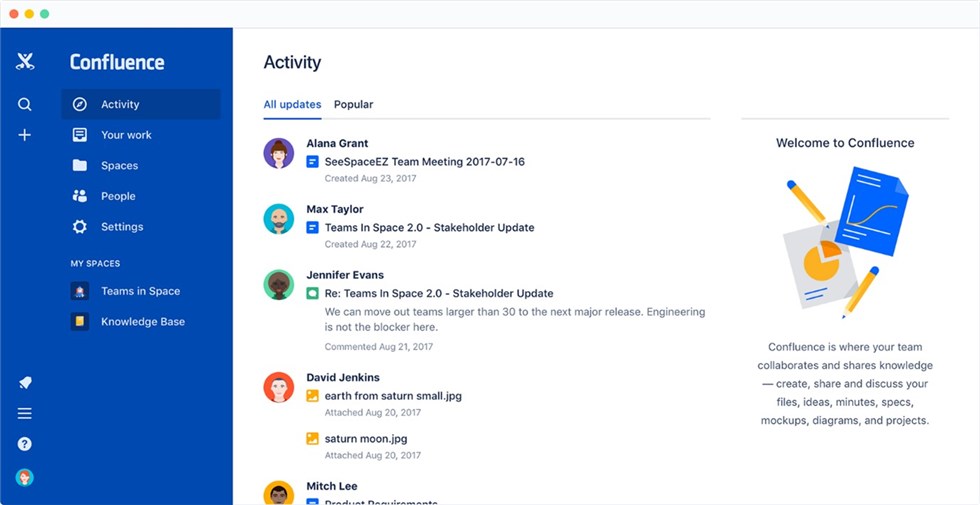
Open Source Knowledge Base – Confluence
Supported Platforms
- Microsoft Windows
- MacOS (evaluations only)
- Linux
- iOS
- Android
Key Features
- It provides a simple interface for creating and editing documents.
- It also provides access control features that allow teams to manage who can view and edit information.
- It provides a range of templates and macros that make it easy to standardize information and automate certain processes.
- It allows teams to add comments and feedback to documents.
Best Used For:
Confluence is an ideal solution for enterprise-level knowledge management as it piles information together and improves collaboration.
ProProfs
Are you looking to streamline customer support, manage internal processes, or create an organized repository of information? ProProfs has the tools you need to succeed! With its user-friendly interface, robust features, and flexible customization options, ProProfs makes it easy to create and manage a centralized knowledge base, foster collaboration and knowledge sharing, and improve overall productivity.

Open Source Knowledge Base – ProProfs
Supported Platforms
- Windows
- MacOS
- Linux
- iOS
- Android
Key Features
- ProProfs provides user management capabilities, allowing administrators to manage user access and permissions.
- It easily tracks and analyzes knowledge by providing analytics and reporting features.
- It provides advanced search and navigation capabilities.
- It can be easily integrated with other useful tools.
Best Used For:
ProProfs is most effectively utilized for managing and sharing internal knowledge within a business environment.
KnowledgeOwl
Looking for another cloud-based knowledge base software? KnowledgeOwl is your solution! Whether you want to create a centralized knowledge base or a platform that offers a range of features and customization options, KnowledgeOwl is your ideal solution as it makes it easier for teams to find and use information, reducing the time spent.
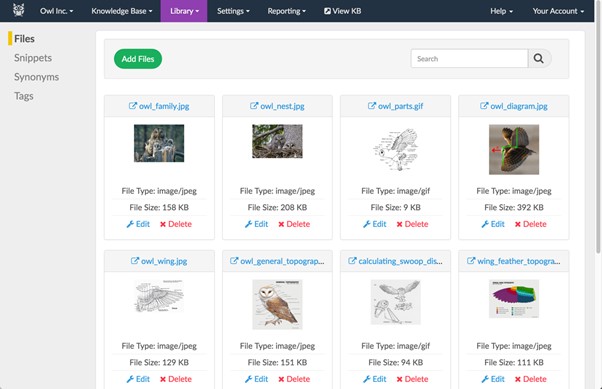
Open Source Knowledge Base – KnowledgeOwl
Supported Platforms
- Windows
- MacOS
- Linux
- iOS
- Android
Key Features
- It provides a collaborative authoring environment that makes it easy for teams to work together on creating and updating articles.
- It also provides organizations with detailed analytics and reporting tools.
- It also provides dynamic content blocks that allow organizations to add dynamic and interactive content.
- It offers automated workflows that allow organizations to streamline their knowledge management processes.
Best Used For:
Knowledge Owl is best used for internal knowledge management as it is easy for organizations to manage and distribute knowledge effectively, improving efficiency and productivity.
CloudTutorial
CloudTutorial provides organizations with the tools to manage their knowledge effectively and ensure that their information is always up-to-date and accessible. The software’s cloud-based architecture means that organizations can access their knowledge base from anywhere, at any time, making it ideal for remote teams and organizations with multiple locations.
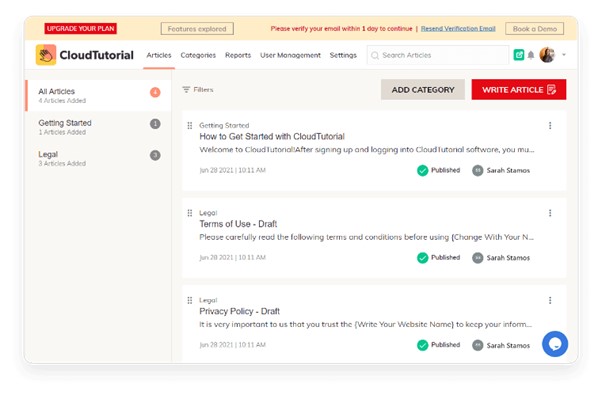
Open Source Knowledge Base – CloudTutorial
Supported Platforms
- Windows
- MacOS
- Linux
- iOS
- Android
Key Features
- It allows users to create interactive tutorials and quizzes to engage and test the knowledge of their audience.
- It provides customization options for branding and design.
- It supports multiple languages for a global audience.
- It offers a mobile-responsive design.
Best Used For:
With its interactive learning features, social learning platform, and gamification elements, CloudTutorial is best used for internal knowledge sharing and training within an organization.
MyBase
Are you a PC or laptop user looking for an efficient knowledge base? MyBase is for you! With myBase, users can organize information in a hierarchical structure and easily find what they want with its advanced search capabilities. It can be used for personal or professional purposes and offers many features, including document management, knowledge base creation, and much more.
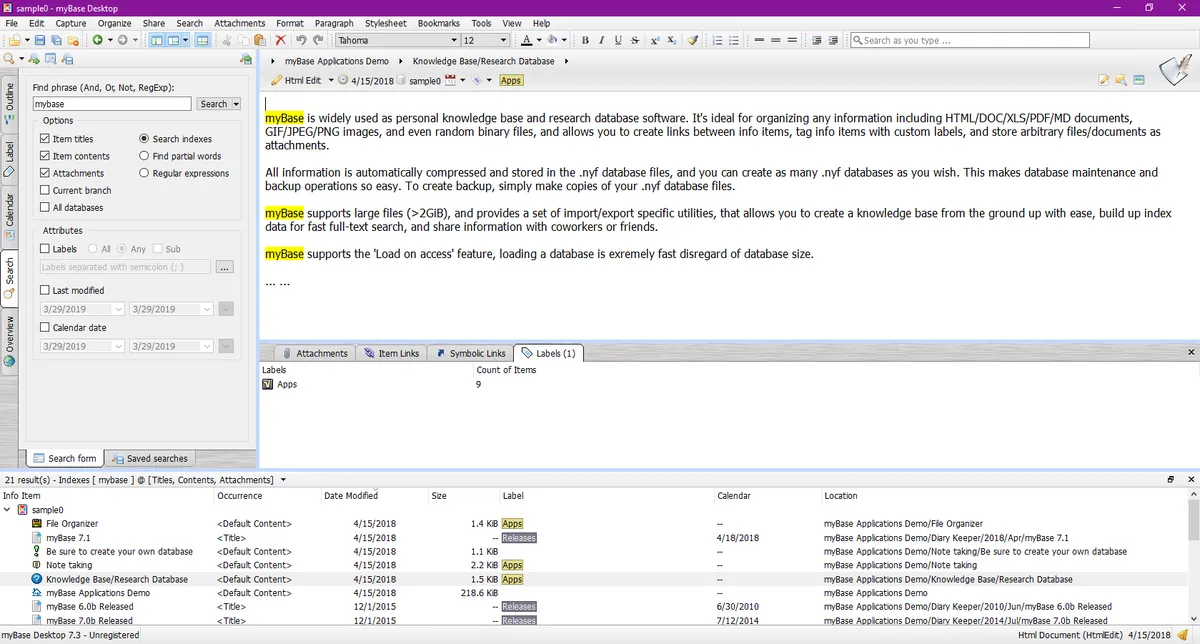
Open Source Knowledge Base – MyBase
Supported Platforms
- Windows
- MacOS
- Linux
Key Features
- It allows users to take notes in a structured manner
- It offers powerful text-editing tools, such as customizable font and paragraph styles.
- It supports various media types, including text, images, audio, and video.
- It has an intuitive, user-friendly interface.
Best Used For:
myBase is best used for internal knowledge management as it can help streamline internal processes and increase efficiency.
eXo Platform
Are you looking for a highly customizable and scalable platform? Exo Platform is your answer! With the eXo Platform, organizations can improve collaboration and communication, increase productivity, and drive innovation. It is an open-source digital workplace solution and offers a wide range of features, including a knowledge base, forums, and many more.
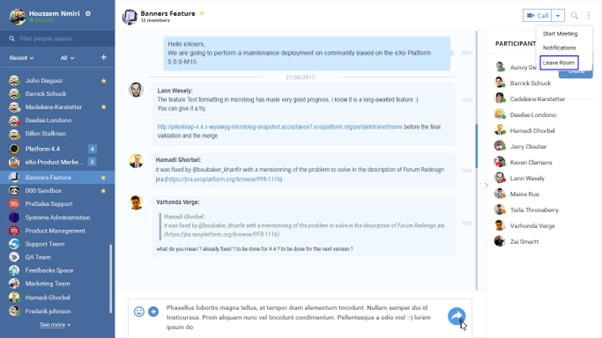
Open Source Knowledge Base – eXo Platform
Supported Platforms
- Windows
- MacOS
- Linux
- iOS
- Android
Key Features
- It incorporates gamification elements such as badges, points, and leaderboard
- It provides a social intranet where employees can connect, share information, and collaborate in real time.
- It also has a mobile-first design.
- It also features advanced analytics and reporting capabilities.
Best Used For:
eXo Platform is best used for enterprise-level knowledge management, offering a centralized internal knowledge and collaboration platform.
xWiki
Looking for a good solution for internal knowledge management and collaboration? Try out xWiki! It is yet another knowledge-based management tool that offers a powerful and flexible platform for collaborative content creation, management, and organization. It is written in Java, iterates over your database, and is highly scalable.
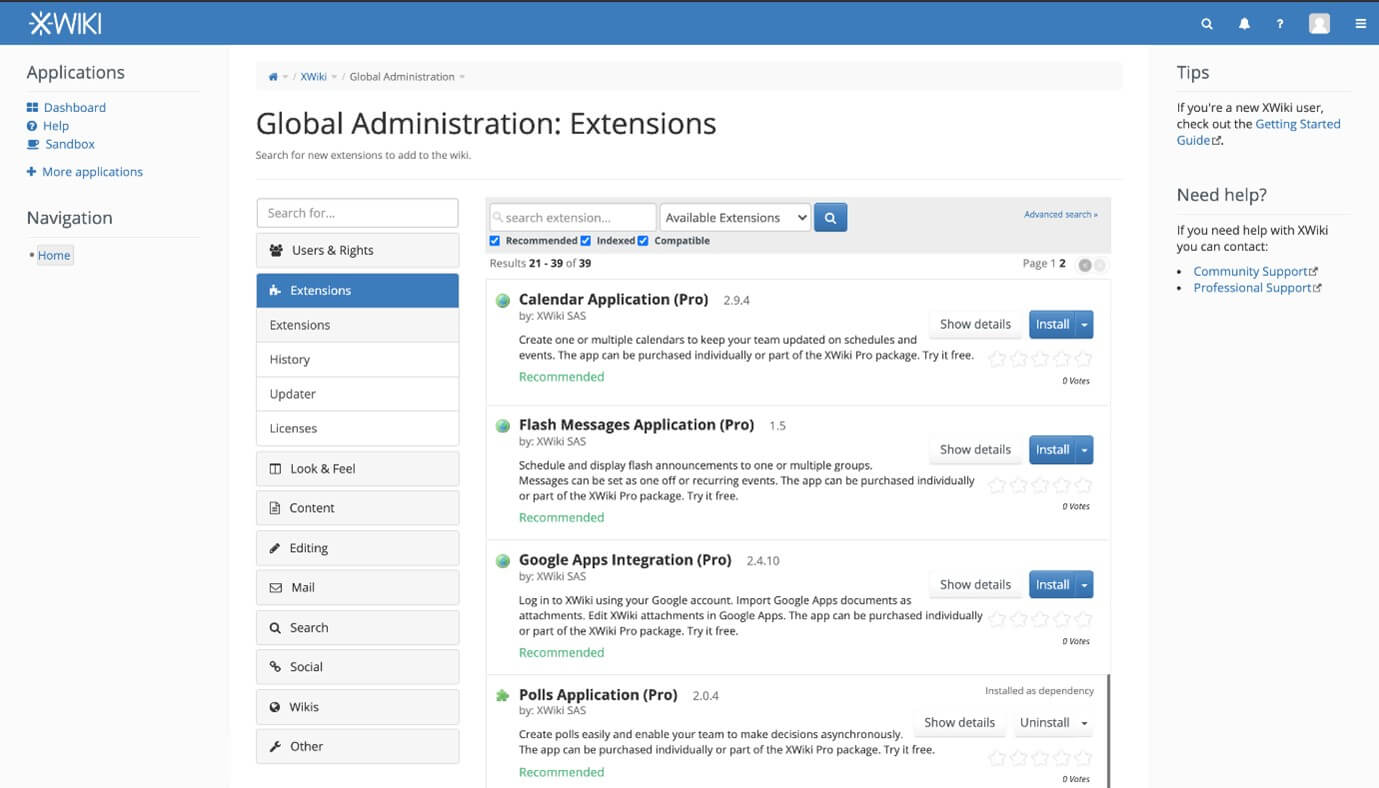
Open Source Knowledge Base – xWiki
Supported Platforms
- Windows
- MacOS
- Linux
- iOS
- Android
Key Features
- It provides robust security features.
- users can create and edit pages using a simple WYSIWYG editor.
- IT supports advanced features such as templates, macros, and extensions.
- It has an attractive user interface.
Best Used For:
xWiki is quite famous and used as an internal knowledge database due to its collaborative tools, making it an ideal solution to work with as a team.
Documize
Wondering how you can centralize your data in one place with minimal effort? Try Documize! Documize is designed to improve productivity and streamline document management, making it easier for teams to access, share, and collaborate on their most important information. Overall, it is a great way to create a pool of knowledge.
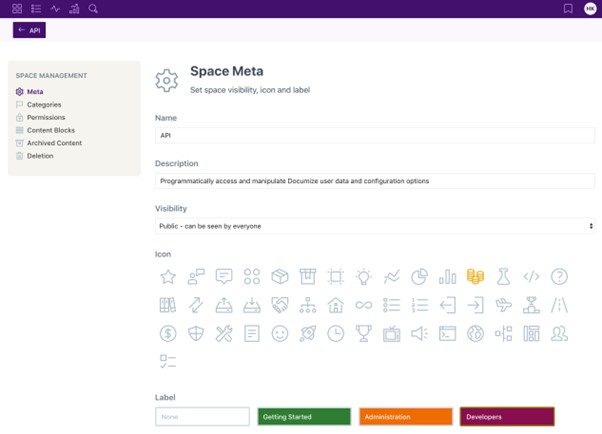
Open Source Knowledge Base – Documize
Supported Platforms
- Windows
- MacOS
- Linux
- iOS
- Android
Key Features
- It allows users to organize documents using labels with zero-folders.
- It allows reusable templates.
- It provides a control version mechanism to approve and commit changes.
- It enables you to divide sections and fill them with code, pdf, etc.
Best Used For:
Documize makes it easier for employees to access and use the information they need to do their jobs effectively, making it a best-used internal knowledge tool.
Zoho Wiki
Wondering if there is an easy-to-use knowledge-base management tool? You should give Zoho Wiki a shoti! It is a tool you can use to create and share any knowledge in your teams or organization according to your needs and requirement. It ensures the safety of your information with its customizable permission levels for workspaces and different pages.
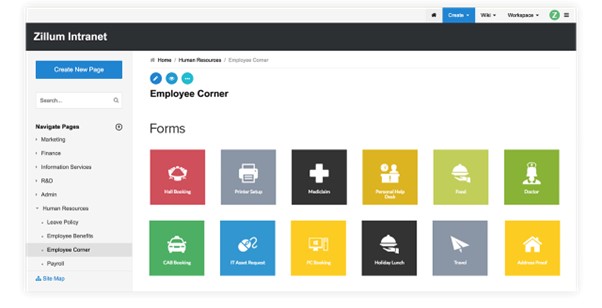
Open Source Knowledge Base – Zoho Wiki
Supported Platforms
- Windows
- MacOS
- Linux
- iOS
- Android
Key Features
- It offers a completely customizable workspace to tailor your needs.
- It provides user administration the right to add or remove users.
- It also offers embedding media into the wikis to make them more user-centered.
- It has a “Watch the wiki” option that alerts you of every change in the wiki.
Best Used For:
Due to its immense collaboration and sharing of important data features, Zoho Wiki is best used as an internal knowledge base.
Final Thought
To summarize, an open-source knowledge base is a central repository for company information and promotes employee collaboration. Selecting the right software for your knowledge base can be challenging, as many options are available in the market. We hope this article has provided valuable insights into making an informed decision. If you found it helpful, please share it with your colleagues and network. If you have further questions or concerns, don’t hesitate to reach out in the comments below.



